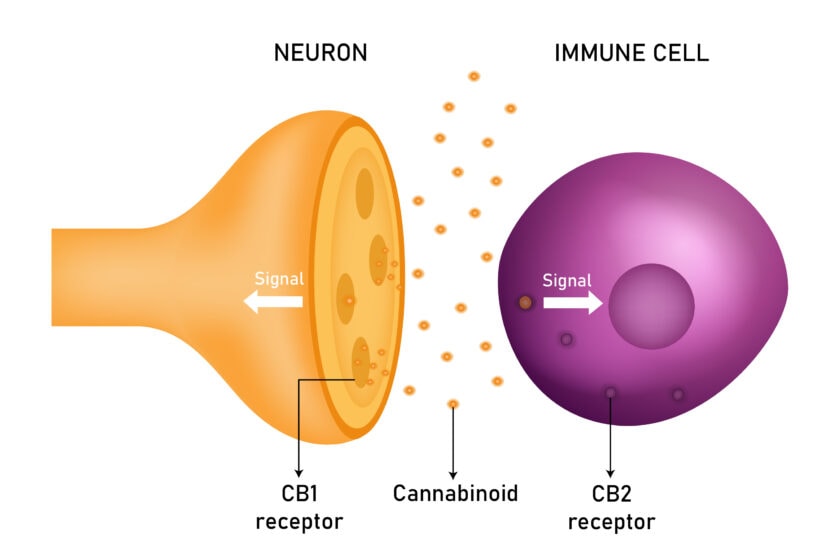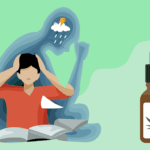Key takeaways:
- The endocannabinoid system (ECS) is a group of molecules and receptors found throughout the body. They regulate brain function, immunity, appetite, and most other major bodily processes.
- The ECS is activated by molecules called cannabinoids. Your body can make its own endocannabinoids and also interact with those found in cannabis, like CBD and THC.
- You can help your ECS function optimally by eating a healthy diet rich in omega-3 fatty acids, exercising, and following other healthy habits.
You may have heard of the endocannabinoid system (ECS) because of its involvement in the effects of cannabis and CBD. But the reality is that it’s vital to nearly every aspect of our health and that of most other animals (1).
Despite its critical role, science has much to learn about the ECS. It wasn’t discovered until the 1990s, and researchers are still investigating its inner workings and involvement in a wide range of diseases.
In this article, we’ll delve into the current research on the ECS, how it works, and natural ways to support it.
Table of Contents
- Components of the Endocannabinoid System
- What Are Endocannabinoids?
- Functions of the Endocannabinoid System
- How Does Cannabis Interact With the Endocannabinoid System?
- Supporting Your Endocannabinoid System
- The Endocannabinoid System: Clinical Implications
- The Endocannabinoid System: Essential To Good Health
Components of the Endocannabinoid System
The ECS consists of three main components which work together to regulate various processes in the body:
- Endocannabinoids. These compounds are naturally produced in our bodies and play a central role in the ECS. Two primary endocannabinoids have been identified so far: anandamide (AEA) and 2-arachidonoylglycerol (2-AG) (1).
- Receptors. Two types of ECS receptors have been officially identified to date: CB1, primarily found in the brain, and CB2, which is most abundant in immune cells (2). There may be more cannabinoid receptors, with the “orphan” receptor GPR55 being a popular candidate, but further research is needed (3).
- Enzymes. Special enzymes help build and break down endocannabinoids. The most important ones are FAAH and MAGL, which act as a clean-up crew to break down anandamide and 2-AG.
You can think of endocannabinoids as keys and receptors as the locks they fit into. Just as a key fits a specific lock, endocannabinoids bind to specific receptors in different areas of the body. When this happens, the associated cells produce a response, such as reducing pain or anxiety.

What Are Endocannabinoids?
Endocannabinoids are compounds that are naturally produced by the body (endo meaning “within the body”). They are made on-demand as needed, binding to cannabinoid receptors found throughout the brain, nervous system, digestive system, and other areas (4).
Endocannabinoids are not the only cannabinoids that occur in nature. Certain plants—including cannabis plants, but also echinacea, rhododendron, and others—produce cannabinoids as well (5, 6). Because they are found in plants, they’re known as phytocannabinoids.
Over one hundred phytocannabinoids have been discovered, but the most widely researched are THC and CBD. These and other phytocannabinoids can interact with the ECS in a similar way to endocannabinoids (7). That’s what makes it possible to use cannabis for therapeutic purposes.
Functions of the Endocannabinoid System
ECS receptors are found all over the body, from the brain to the skin, digestive tract, glands, reproductive organs, and more. This allows the ECS to regulate vital functions throughout the body, including:
- Emotions, stress, mood, and sleep
- Pain
- Appetite and metabolism
- Digestion and gut health
- Memory and cognition
- Temperature
- Reproduction
- Inflammation and other immune system functions
A properly functioning ECS is crucial for maintaining homeostasis — a state of bodily balance (8). It’s when this balance is disrupted that health problems follow.
To illustrate, consider that your immune system causes inflammation following injury or illness to fight off infections and initiate the healing process. But if it fails to wind down after doing its job, it may continue to attack healthy tissue and cause chronic inflammation.
This is where the ECS can come in to signal immune cells to turn off, restoring balance. And it’s not just the immune system—the ECS performs this regulating function with virtually all systems in the body.

How Does Cannabis Interact With the Endocannabinoid System?
Cannabis is rich in phytocannabinoids like CBD and THC, which can interact with cannabinoid receptors and other others of the ECS. Phytocannabinoids, and CBD in particular, can also interact with many other non-cannabinoid targets like receptors, enzymes, and proteins.
THC Effects on the ECS
THC is typically the most abundant cannabis cannabinoid, and it’s also the main psychoactive component of the plant. THC can bind to both CB1 and CB2 receptors but has an especially high affinity for CB1 receptors, which are concentrated in the brain (9).
When THC binds to these receptors, it causes the psychoactive effects associated with cannabis use — aka the “high.” Activation of the CB1 receptor also causes other effects like increased appetite, pain relief, and more.
CBD Effects on the ECS
Unlike THC, CBD does not directly affect CB1 or CB2 receptors. Instead, research suggests that CBD can function as an allosteric modulator of CB1 (10).
This means that CBD binds to a special site on the CB1 receptor and reduces its response to other cannabinoids. This may explain how CBD may reduce anxiety and other unwanted effects of THC.
CBD also affects the ECS by inhibiting FAAH, the enzyme responsible for breaking down anandamide (11). In doing so, CBD indirectly increases anandamide levels in the body.
Aside from that, CBD has also been shown to affect dozens of non-ECS molecules, like serotonin 5HT1A receptors, with one study highlighting a whopping 76 molecular targets (12, 13).
More research is needed to fully understand how CBD and minor phytocannabinoids affect the ECS and other systems.
Supporting Your Endocannabinoid System
It’s clear that the ECS plays a huge role in your well-being. The great news is that you can support its optimal functioning with positive lifestyle habits like a healthy diet, exercise, and meditation (14).
Diet
Endocannabinoids are made from lipids, so the body needs healthy fats to produce them. Be sure your diet includes sources of omega-3 fatty acids like fish (15).
The ratio of omega-6 to omega-3 fatty acids in your diet is particularly important (16). The ideal ratio is thought to be around 4:1 or 5:1. In Western diets, the ratio is often much higher — up to 20:1 or more, which is associated with numerous diseases.
Other foods that can affect the endocannabinoid system include:
- Catechins found in tea leaves, which may mimic the effects of cannabinoids and bind to cannabinoid receptors (17).
- The terpene beta-caryophyllene, which is considered a “dietary cannabinoid” for its ability to activate CB2 receptors, causing anti-inflammatory effects (18). It’s not only found in cannabis, but also many plants and particularly spices, including citrus fruits, basil, cinnamon, pepper, lavender, rosemary, cloves, and others.

Exercise
Physical activity has been shown to increase circulating endocannabinoid levels, which can help with mood, cognition, brain inflammation, and pain relief (19, 20).
In fact, there’s some evidence that the euphoric feeling known as “runner’s high” that occurs during and after endurance exercise may be caused by endocannabinoids (21).
Healthy Sleep Habits
Quality sleep is essential for supporting the endocannabinoid system. For example, there’s evidence that sleep deprivation disturbs the natural variations of anandamide in the body (22).
Meditation & Acupuncture
Research has shown that meditation and other mindfulness practices can have a long list of benefits, including the reduction of stress, anxiety, and pain. Evidence suggests these benefits may be at least partly related to increased endocannabinoid levels (23).
There’s also growing evidence that acupuncture’s pain-relieving, anti-inflammatory, and other benefits are mediated by the endocannabinoid system (24, 25).
The Endocannabinoid System: Clinical Implications
Because of its far-reaching effects on the body, researchers believe that targeting the ECS has exciting potential for treating many serious conditions, including (26):
- Inflammatory disorders
- Neurodegenerative disorders
- Reproductive diseases
- Cancer
- Metabolic disorders
Research also suggests that targeting the ECS may be effective in treating autoimmune diseases like rheumatoid arthritis and multiple sclerosis (27).
Clinical Endocannabinoid Deficiency
Additionally, there’s growing evidence that insufficient levels of endocannabinoids — a proposed condition called clinical endocannabinoid deficiency (CED) — may be responsible for a variety of chronic conditions like migraines, irritable bowel syndrome (IBS), and fibromyalgia (28).
This could also explain why these conditions are so challenging to treat. If CED is indeed the culprit, targeting the ECS through cannabinoid therapies may offer relief.
The Endocannabinoid System: Essential To Good Health
The evidence is in: the endocannabinoid system plays a crucial part in keeping us healthy from head to toe. In fact, we may be able to treat many symptoms and conditions by targeting this essential system.
Although cannabis and CBD are the most popular methods of supporting your ECS, you can also keep in top shape with a healthy diet, regular exercise, good sleep, and other positive practices like meditation.
References
- Silver, Robert J. “The endocannabinoid system of animals.” Animals 9.9 (2019): 686.
- Komarnytsky, Slavko, et al. “Endocannabinoid system and its regulation by polyunsaturated fatty acids and full spectrum hemp oils.” International Journal of Molecular Sciences 22.11 (2021): 5479.
- Ryberg, E., et al. “The orphan receptor GPR55 is a novel cannabinoid receptor.” British journal of pharmacology 152.7 (2007): 1092-1101.
- Huang, Wen‑Juan, Wei‑Wei Chen, and Xia Zhang. “Endocannabinoid system: Role in depression, reward and pain control.” Molecular medicine reports 14.4 (2016): 2899-2903.
- Gülck, Thies, and Birger Lindberg Møller. “Phytocannabinoids: origins and biosynthesis.” Trends in plant science 25.10 (2020): 985-1004.
- Bauer, Rudolf, Karin Woelkart, and Outi MH Salo-Ahen. “CB receptor ligands from plants.” Current Topics in Medicinal Chemistry 8.3 (2008): 173-186.
- de Melo Reis, Ricardo Augusto, et al. “Quality of life and a surveillant endocannabinoid system.” Frontiers in Neuroscience (2021): 1409.
- Almogi-Hazan, Osnat, and Reuven Or. “Cannabis, the Endocannabinoid System and Immunity—the Journey from the Bedside to the Bench and Back.” International journal of molecular sciences 21.12 (2020): 4448.
- Vučković, Sonja, et al. “Cannabinoids and pain: new insights from old molecules.” Frontiers in pharmacology 9 (2018): 1259.
- Jakowiecki, Jakub, et al. “Allosteric modulation of the CB1 cannabinoid receptor by cannabidiol—A molecular modeling study of the N-terminal domain and the allosteric-orthosteric coupling.” Molecules 26.9 (2021): 2456.
- de Almeida, Douglas L., and Lakshmi A. Devi. “Diversity of molecular targets and signaling pathways for CBD.” Pharmacology research & perspectives 8.6 (2020): e00682.
- Russo, Ethan B., et al. “Agonistic properties of cannabidiol at 5-HT1a receptors.” Neurochemical research 30 (2005): 1037-1043.
- Mlost, Jakub, Marta Bryk, and Katarzyna Starowicz. “Cannabidiol for pain treatment: focus on pharmacology and mechanism of action.” International journal of molecular sciences 21.22 (2020): 8870.
- McPartland, John M., Geoffrey W. Guy, and Vincenzo Di Marzo. “Care and feeding of the endocannabinoid system: a systematic review of potential clinical interventions that upregulate the endocannabinoid system.” PloS one 9.3 (2014): e89566.
- Vago, Riccardo, et al. “The Mediterranean Diet as a Source of Bioactive Molecules with Cannabinomimetic Activity in Prevention and Therapy Strategy.” Nutrients 14.3 (2022): 468.
- Bosch-Bouju, Clémentine, and Sophie Layé. “Dietary omega-6/omega-3 and endocannabinoids: implications for brain health and diseases.” Cannabinoids in health and disease (2016): 111-142.
- Korte, G., et al. “Tea catechins’ affinity for human cannabinoid receptors.” Phytomedicine 17.1 (2010): 19-22.
- Gertsch, Jürg, et al. “Beta-caryophyllene is a dietary cannabinoid.” Proceedings of the National Academy of Sciences 105.26 (2008): 9099-9104.
- Watkins, Bruce A. “Endocannabinoids, exercise, pain, and a path to health with aging.” Molecular aspects of medicine 64 (2018): 68-78.
- Charytoniuk, Tomasz, et al. “Can physical activity support the endocannabinoid system in the preventive and therapeutic approach to neurological disorders?.” International journal of molecular sciences 21.12 (2020): 4221.
- Siebers, Michael, Sarah V. Biedermann, and Johannes Fuss. “Do endocannabinoids cause the runner’s high? Evidence and open questions.” The Neuroscientist (2022): 10738584211069981.
- Vaughn, Linda K., et al. “Endocannabinoid signalling: has it got rhythm?.” British journal of pharmacology 160.3 (2010): 530-543.
- de Melo Reis, Ricardo Augusto, et al. “Quality of life and a surveillant endocannabinoid system.” Frontiers in Neuroscience (2021): 1409.
- Hu, Bo, et al. “The endocannabinoid system, a novel and key participant in acupuncture’s multiple beneficial effects.” Neuroscience & Biobehavioral Reviews 77 (2017): 340-357.
- Lin, Jaung-Geng, Peddanna Kotha, and Yi-Hung Chen. “Understandings of acupuncture application and mechanisms.” American journal of Translational Research 14.3 (2022): 1469.
- Meccariello, Rosaria. “Endocannabinoid system in health and disease: Current situation and future perspectives.” International Journal of Molecular Sciences 21.10 (2020): 3549.
- Giorgi, Valeria, et al. “Cannabis and autoimmunity: possible mechanisms of action.” ImmunoTargets and Therapy (2021): 261-271.
- Russo, Ethan B. “Clinical endocannabinoid deficiency reconsidered: current research supports the theory in migraine, fibromyalgia, irritable bowel, and other treatment-resistant syndromes.” Cannabis and cannabinoid research 1.1 (2016): 154-165.

Gleb is a freelance writer from Vancouver, Canada specializing in CBD and cannabis. He’s read thousands of studies on CBD and other supplements, helping him translate complex science into plain language. Gleb has tried and reviewed dozens of CBD brands and products, written third-party testing reports, and knows the CBD industry inside and out. When not writing, he likes to kickbox, travel, and tell everyone how awesome intermittent fasting is.





